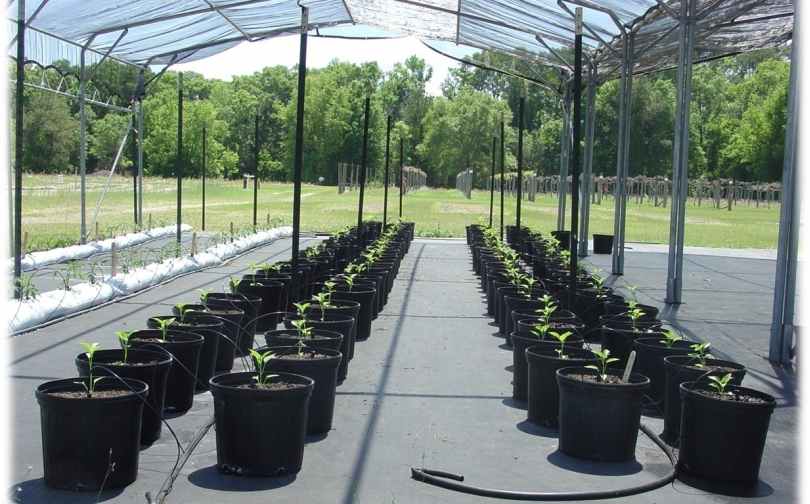Irrigation Options For Protected Culture


The peppers in these containers have individual irrigation emitters. Photo credit: Bob Hochmuth
The first thing any greenhouse expert will tell you about producing a crop undercover is to have a market for that crop before doing anything else.
For field producers who have done their homework and want to produce greenhouse tomatoes, peppers, or ornamental grower who are looking to make a switch to vegetables, there are several things to consider about irrigation before successfully getting your crop to market.
According to George Hochmuth, a Professor in the Soil and Water Science Department at the University of Florida, first consider your production system. Determine if you will start out in the soil, or if you are a greenhouse producer, decide if you will grow vegetables in pots using a mix.
If you are a field producer and plan to grow in the soil, a high tunnel using plastic mulch and a drip irrigation system should suffice if your plan is season extension and frost protection. If you have a more wide-reaching market and need greater production capacity throughout the year, then perhaps it may be best to go more high-tech with a greenhouse.
For ornamental growers making the conversion to vegetables planning to stick with soilless culture in a container, they will need an irrigation system that involves micro-irrigation with emitters.
Get To Know Your Irrigation System
“Now it’s time to make another decision,” Hochmuth says. “If the grower is going to use micro-irrigation, then he must know something about the design of the irrigation system so he can accommodate the number of pots or containers.”
The grower also needs to determine if he will have one small greenhouse with one zone that can be irrigated at one time, or will part of the plan include a larger layout that will encompass designing the systems into zones? The plan also may include different planting dates or different crops that will need to be irrigated on different schedules.
“You will have to think about the crop, the size of the operation, and the size of the source of water,” Hochmuth explains. “If you have a small well that can only deliver so many gallons per minute, you will need to think about the size and the scope of [your irrigation system].”
In fact, Hochmuth encourages growers to sit down with an irrigation company experienced in greenhouse microirrigation systems and discuss specific plans, to make sure they have the right pipes and parts for the system.
Water Source And Irrigation System
For field producers going down the protected culture road planning to go beyond a high tunnel and use a greenhouse, they need to consider the water source itself, Hochmuth says.
“If [field growers] have been used to growing vegetables outdoors with overhead sprinklers, they will have to think about this aspect of production,” he says. “If they used drip outdoors, then they have already analyzed the water source and the need for filtration to get rid of physical particles that come up from the well, such as limestone and sand. They also know the importance of chemically treating the water to prevent irrigation emitter plugging.”
Micro-Irrigation Benefits
Whether coming from the field or ornamental side and the plan is to produce in a greenhouse structure, Hochmuth says some type of microirrigation system typically will be the best approach.
“Drip irrigation works well with the soil-based/mulch systems and a micro-emitter type irrigation system will work with containers,” he explains. “These micro-irrigation systems are easy to manage in greenhouses and will provide the greatest efficiency in water and nutrient delivery.”
It’s important to note that the way drip tape and a drip irrigation system are used in the field is not the same as in the greenhouse. A drip system can be difficult to manage inside the greenhouse especially if containers are used.
“You have to precisely place the drip tape, so the drip emitters are placed over the containers,” Hochmuth explains. “Typically, growers have individual emitters coming from a supply tube up to the container and they irrigate each individual container with its own drip emitter or microjet emitter.”
The Pros And Cons
Looking at the big picture, Hochmuth says growers need to think long and hard about their investment in the irrigation system and the technologies they will need to produce a crop.
“[The grower] needs to think about microjets and injecting fertilizers and how all of these activities will be controlled, which involves automation in some fashion,” he says.
A final word of advice? Hochmuth circles back to one of his initial statements: Make sure you have a market for your produce. And, of equal importance: Do all the up-front study and planning for your crop and production system so you avoid frustration and costly mistakes.
Keys to Success
George Hochmuth, a Professor in the Soil and Water Science Department at the University of Florida, says no matter what type of cultural system you use to produce your crops, follow these pointers to get the most from your irrigation system.
- Water quality. Know your water source quantity and quality. Know its issues and potential problems that will need to be addressed through filtration and physically removing things that come up from the well. You also must know the potential chemical problems of the water that are likely to lead to plugging of the emitters, like bicarbonates and iron. These will need to be treated chemically.
- Irrigation System Design. Design the irrigation system so you can supply water if you opt to go into container production. For example, if you produce tomatoes, which are typically large plants, they will need a sizable amount of water every day, so the irrigation system has to be able to deliver that amount of water.The difference between container production in the greenhouse versus soil production outdoors is that the soil, particularly heavy soil, has a large water holding capacity. So the soil can store water for several days. In a greenhouse, there is not a lot of water holding capability in a small container housing a big plant. The end result is you will need to irrigate more frequently and you will need a system capable of delivering water on a timely basis. Also make sure you have electrical backup (a generator) to maintain pumping capability during power outages.
- Management of the Irrigation System. Determine if it will be manually operated or if it will be automated. If it needs to be automated, based on your production system, you will need an electronic controller to turn the system on and off. Also remember the importance of cleanliness. At the end of the season, consider an acid treatment so the emitters will stay open for the next season or the next time the system is used.
- Nutrient Supply. Strategize on how to supply nutrients to the irrigation system. If you are using microirrigation and containers, look at total fertigation of the nutrients your plants need, which includes the use of proportioning pumps or injectors to get the nutrients out of a stock tank and injecting them in the water. Know the nutrient needs of the crop at the various growth stages.
Peppers in containers with individual irrigation emitters; photo Bob Hochmuth










